Content Osmosis in Television Programmes: The Inclusion of News in the Spanish Magazines Espejo Público and Mañaneros
Abstract
1. Introduction
1.1. Nature of Television News and the Concept of News Osmosis
1.2. Genre and Format
1.3. Hybridisation of Content and Genres in Television Formats
1.4. Hypertelevision and Infotainment
1.5. Limitations and New Challenges in Preserving Credibility
2. Objectives and Research Questions
3. Materials and Methods
4. Results and Discussion
4.1. Thematic Focus of Morning Magazine News Content
4.2. Framing of the News
4.3. Format of the News
4.4. The Magazine Presenters’ Evaluative Stances
4.5. The Magazine TV Journalists’ Evaluative Stances
4.6. Use of Sources
4.7. Elements Recreating the Atmosphere of News Programmes
4.8. Live News: Types of Live Connections on the Ground
5. Conclusions
Funding
Institutional Review Board Statement
Informed Consent Statement
Data Availability Statement
Conflicts of Interest
References
- Abrahamson, D., & Prior Miller, M. R. (Eds.). (2015). The routledge handbook of magazine research: The future of the magazine form. Routledge. [Google Scholar]
- Bañon Castellón, L. (2021). Audiovisual verification in the evo-lution of television newsrooms: Al Jazeera and the transition from satellite to the cloud. Anàlisi: Quaderns de Comunicació i Cultura, 64, 85–102. [Google Scholar] [CrossRef]
- Baym, G. (2016). Journalism and the hybrid condition: Long-form television drama at the intersections of news and narrative. Journalism, 18(1), 11–26. [Google Scholar] [CrossRef]
- Berrocal, M., Redondo, C., Martín Jiménez, E., & Campos, E. (2014). La presencia del infoentretenimiento en los canales generalistas de la TDT española. Revista Latina de Comunicación Social, 69, 85–103. [Google Scholar] [CrossRef]
- Britannica. (2022). Osmosis. In Britannica. Available online: https://www.britannica.com/science/osmosis (accessed on 7 June 2025).
- Cebrián, M. (1992). Géneros informativos audiovisuales. Editorial Ciencia 3. [Google Scholar]
- Chadwick, A. (2017). The hybrid media system: Politics and power (2nd ed.). Oxford University Press. [Google Scholar]
- Connolly-Ahern, C., Ahern, L. A., & Bortree, D. S. (2009). The effectiveness of stratified constructed week sampling for content analysis of electronic news source archives: AP newswire, business wire, and PR newswire. Journalism & Mass Communication Quarterly, 86(4), 862–883. [Google Scholar] [CrossRef]
- Cui, X., & Xu, Q. (2021). Television vs social media: Examining the effects of media platforms on audience’s emotion and sense of social solidarity during a media event. Western Journal of Communication, 85(5), 632–653. [Google Scholar] [CrossRef]
- Dahlgren, P., & Sparks, C. (1992). Journalism and popular culture. Sage. [Google Scholar]
- Diaz, R. (2017). La información periodística en televisión. Síntesis. [Google Scholar]
- Doveling, K. (2021). Emotions and the media interdisciplinary perspectives. In Routledge international handbook of emotions and media. Routledge. [Google Scholar]
- Eco, U. (1986). TV, la transparencia perdida, en La estrategia de la ilusión. Lumen. [Google Scholar]
- El País/elDiario.es. (2025, April 1). Audiencias: Antena 3 lidera marzo con 12.5%, y la mañana en 11.4%. Available online: https://www.eldiario.es/vertele/audiencias-tv/mes-marzo-2025-antena-3-lidera-delante-telecinco-supera-primera-vez-la-1-temporada-cuatro-la-sexta_1_12178428.html (accessed on 29 June 2025).
- Entman, R. M. (1993). Framing: Toward clarification of a fractured paradigm. Journal of Communication, 43(4), 51–58. [Google Scholar] [CrossRef]
- Esser, F. (1999). ‘Tabloidization’ of news: A comparative analysis of Anglo American and German press journalism. European Journal of Communication, 14(3), 291–324. [Google Scholar] [CrossRef]
- Fernández-García, N. (2017). Fake news: Una oportunidad para la alfabetización mediática. Nueva Sociedad, 269, 66–67. Available online: https://biblat.unam.mx/hevila/Nuevasociedad/2017/no269/8.pdf (accessed on 15 June 2025).
- Ferré Pavía, C. (2013). Infoentretenimiento: El formato imparable de la era del espectáculo. UOC. [Google Scholar]
- Früh, W., & Wirth, W. (1997a). Content analysis. In W. Donsbach (Ed.), Handbook of communication science (pp. 385–407). Westdeutscher Verlag. [Google Scholar]
- Früh, W., & Wirth, W. (1997b). Positives und negatives Infotainment: Zur Rezeption unterhaltsam aufbereiteter TV-Informationen. In G. Bentele, & M. Haller (Eds.), Aktuelle entstehung von öffentlichkeit (pp. 367–381). Universitätsverlag Konstanz. [Google Scholar]
- García Avilés, J. A. (2007). El infoentretenimiento en los informativos líderes de audiencia en la Unión Europea. Anàlisi, 35, 47–63. Available online: https://dspace.umh.es/bitstream/11000/4557/1/22-infoentretenimiento%20garcia%20Avil%C3%A9s.pdf (accessed on 20 July 2025).
- García Avilés, J. A. (2021). El reportaje de infoentretenimiento: Evolución del género en las televisiones generalistas en España (1990–2020). Revista de Comunicación. Available online: https://revistadecomunicacion.com/article/view/2379 (accessed on 17 June 2025).
- Gordillo, I. (2009). Manual de narrativa televisiva. Síntesis. [Google Scholar]
- Gordillo, I., Guarinos, V., Checa, A., Ramírez Alvarado, M. d. M., Jiménez-Varea, J., López-Rodríguez, F. J., de los Santos, F., & Pérez-Gómez, M. A. (2022). Hibridaciones de la hipertelevisión: Información y entretenimiento en los modelos de infoentertaiment. COMUNICACIÓN. Revista Internacional De Comunicación Audiovisual, Publicidad Y Estudios Culturales, 1(9), 93–106. [Google Scholar] [CrossRef]
- Graves, L. (2012). Deciding what’s true: Fact-checking journalism and the new ecology of news. Available online: https://core.ac.uk/download/pdf/161442732.pdf (accessed on 1 May 2025).
- Graves, L., & Amazeen, M. (2019). Fact-checking as idea and practice in journalism (J. Nussbaum, Ed.). Oxford University Press. [Google Scholar]
- Gutsche, R. E., & Hess, K. (2019). Geographies of journalism: The imaginative power of place in making digital news. Routledge. [Google Scholar]
- Hallin, D. C., & Mancini, P. (2004). Comparing media systems: Three models of media and politics. Cambridge University Press. [Google Scholar] [CrossRef]
- Hepp, A., & Couldry, N. (2013a). Media events in a global age. Routledge. [Google Scholar]
- Hepp, A., & Couldry, N. (Eds.). (2013b). Conceptualizing mediatization: Contexts, arguments. Wiley. [Google Scholar] [CrossRef]
- Hepp, A., & Couldry, N. (2023). Necessary entanglements: Reflections on the role of a “materialist phenomenology” in researching deep mediatization and datafication. Sociologica, 17(1), 137–153. [Google Scholar] [CrossRef]
- Hester, J. B., & Dougall, E. (2007). The efficiency of constructed week sampling for content analysis of online news. Journalism & Mass Communication Quarterly, 84(4), 811–824. [Google Scholar] [CrossRef]
- Imbert, G. (2008). El transformismo televisivo. Cátedra. [Google Scholar]
- Jenkins, H. (2006). Convergence culture: Where old and new media collide. NYU Press. [Google Scholar]
- Jenkins, H., Ford, S., & Green, J. (2013). Spreadable media: Creating value and meaning in a networked culture. NYU Press. [Google Scholar]
- Karbaum, G. (2017). La producción de los noticieros de televisión y la hibridación de los géneros audiovisuales. Boletín del Centro de Investigación de la Creatividad, UCAL 2. Available online: https://repositorio.ucal.edu.pe/handle/20.500.12637/201 (accessed on 10 June 2025).
- Kellner, D. (2015). Media Spectacle and the crisis of the democracy. Routledge. [Google Scholar]
- Krippendorff, K. (2004). Content analysis: An introduction to its methodology. Sage. [Google Scholar]
- Lacy, S., Robinson, K., & Riffe, D. (1995). Sample size in content analysis of weekly newspapers. Journalism & Mass Communication Quarterly, 72(2), 336–345. [Google Scholar] [CrossRef]
- La Razón. (2025, March 31). Antena 3 arrasa en marzo y se corona de nuevo como líder en todas las franjas. La Razón. Available online: https://www.larazon.es/television/antena-3-arrasa-corona-nuevo-lider-marzo_2025033167eac4e5a1d1a50001e50852.html (accessed on 9 June 2025).
- Lorenzini, B., Osorio-Galeano, S. P., Schmidt, C. P., & Cañon-Montañez, W. (2024). Practical guide to achieve rigor and data integration in mixed methods research. The Journal Investigació Educación en Enfermería, 42(3), e02. [Google Scholar] [CrossRef]
- Lotz, A. D. (2018). We now disrupt this broadcast: How cable transformed television and the internet revolutionized it all. MIT Press. [Google Scholar]
- Marín, C. (2006). El informativo de televisión: Producción, guión y edición audiovisuales. Gedisa. [Google Scholar]
- Martinez Albertos, J. L. (1992). Curso general de redacción periodística: Lenguaje, estilos y géneros periodísticos en prensa, radio, televisión y cine. Paraninfo. [Google Scholar]
- Mateos, C. (2013). La narrativa audiovisual informativa: Transmediación, hibridación y nuevos retos para los medios online. In Narrativas audiovisuales digitales. Convergencia de medios, multiculturalidad y transmedia (pp. 71–114). (V. Guarinos-Galán, & A. Sedeño-Valdellós, Coords.). Fragua. [Google Scholar]
- Meeker, M. (2015). Internet trends 2015. KPCB. Available online: https://www.bondcap.com/report/it15/#view/1 (accessed on 3 August 2025).
- Mejía, C. (2012). Géneros y estilos de redacción en la prensa. Desarrollo y variantes taxonómicas. Correspondencias & Análisis, 2, 201–217. [Google Scholar] [CrossRef][Green Version]
- Mikos, L. (2019). Television as transitional medium. International Journal of Film and Media Arts, 4(1), 90–103. [Google Scholar] [CrossRef]
- Monfort, C. (2025, October 30). La cobertura de la DANA bate récords en consumo televisivo e Iker Jiménez se alza como líder de audiencias con su controvertido seguimiento. Espinof. Available online: https://www.espinof.com/informativos/cobertura-dana-bate-records-consumo-televisivo-e-iker-jimenez-se-alza-como-lider-audiencias-su-controvertido-seguimiento (accessed on 1 July 2025).
- Montero, E., & Ferré-Pavía, C. (2017). Elementos de espectacularización en los informativos televisivos en “prime time”: El caso de Charlie Hebdo. Observatorio, 11(2), 35–60. [Google Scholar] [CrossRef]
- Nielsen, R., & Sambrook, R. (2017). What is happening to television news? Reuters Institute for the Study of Journalism. Available online: https://reutersinstitute.politics.ox.ac.uk/our-research/what-happening-television-news (accessed on 25 May 2025).
- Nielsen News Center. (2024). Nielsen’s May 2024 report of The Gauge: Young Sheldon creates a Big Bang across platforms. Available online: https://www.nielsen.com/news-center/2024/the-gauge-may-2024-young-sheldon-covergent-tv-win (accessed on 10 July 2025).
- Pellicer, N., & Pineda, A. (2014). Información política televisiva y espectacularización: Un análisis comparativo de programas informativos y de infoentretenimiento. Estudios sobre el Mensaje Periodístico, 20(2), 821–839. Available online: https://revistas.ucm.es/index.php/ESMP/article/view/47036 (accessed on 13 April 2025). [CrossRef]
- Pérez, G. (2003). Curso básico de periodismo audiovisual. Eunsa. [Google Scholar]
- Piscitelli, A. (1998). Post-televisión: Ecología de los medios en la era de internet. Paidós. [Google Scholar]
- Plano, C., Anderson, N., Wertz, J., Zhou, Y., Schumacher, K., & Miaskowski, C. (2015). Conceptualizing longitudinal mixed methods designs. Journal of Mixed Methods Research, 9(4), 297–319. [Google Scholar] [CrossRef]
- Prado, E. (2002). Televisión en la era digital: Homogeneización versus diversidad. Telos. Available online: https://telos.fundaciontelefonica.com/archivo/numero051/television-en-la-era-digital-homogeneizacion-versus-diversidad/ (accessed on 5 June 2025).
- Quail, C. (2015). Producing reality: Television formats and reality TV in the Canadian context. Canadian Journal of Communication, 40, 185–201. [Google Scholar] [CrossRef]
- Ramonet, I. (2002). La post-televisión: Multimedia, internet y globalización económica. Icaria. [Google Scholar]
- Reinemann, C., Stanyer, J., Scherr, S., & Legnante, G. (2012). Hard and soft news: A review of concepts, operationalizations and key findings. Journalism, 13(2), 221–239. [Google Scholar] [CrossRef]
- Reuters Institute. (2024). Digital news report. Available online: https://reutersinstitute.politics.ox.ac.uk/sites/default/files/2024-06/RISJ_DNR_2024_Digital_v10%20lr.pdf (accessed on 10 July 2025).
- Salgado, A. (2007). La credibilidad del presentador de programas informativos en televisión: Definiciones y cualidades constitutivas. Comunicación y Sociedad, 20(1), 145–180. [Google Scholar] [CrossRef]
- Saló, G. (2021). ¿Qué es eso del formato? Gedisa. [Google Scholar]
- Santana Mahmut, S., & Sanz de León, V. (2022). El directo con señal móvil en programas informativos de televisión generalista: El caso de Espejo Público de Antena 3. Doxa Comunicación, 34, 55–77. Available online: https://revistascientificas.uspceu.com/doxacomunicacion/article/view/898 (accessed on 10 June 2025). [CrossRef]
- Scolari, C. (2008). Hacia la hipertelevisión: Los primeros síntomas de una nueva configuración del dispositivo televisivo. En Diálogos de la Comunicación. Available online: https://repositori.upf.edu/handle/10230/25464 (accessed on 7 July 2025).
- Thussu, D. (2015). Infotainment. Wiley. Available online: https://onlinelibrary.wiley.com/doi/full/10.1002/9781118541555.wbiepc152 (accessed on 25 February 2025).
- Thussu, D. K. (2007). News as entertainment: The rise of global infotainment. SAGE Publications. [Google Scholar]
- Toffler, A. (1980). The third wave. Bantam Books. [Google Scholar]
- Wikipedia. (2025). Mañaneros 360. En Wikipedia, la Enciclopedia Libre. Available online: https://es.wikipedia.org/wiki/Ma%C3%B1aneros_360 (accessed on 8 March 2025).
- Wolf, M. (1984). Gèneros y televisión. Anàlisi, (9), 189–198. Available online: https://raco.cat/index.php/Analisi/article/view/41275 (accessed on 24 July 2025).
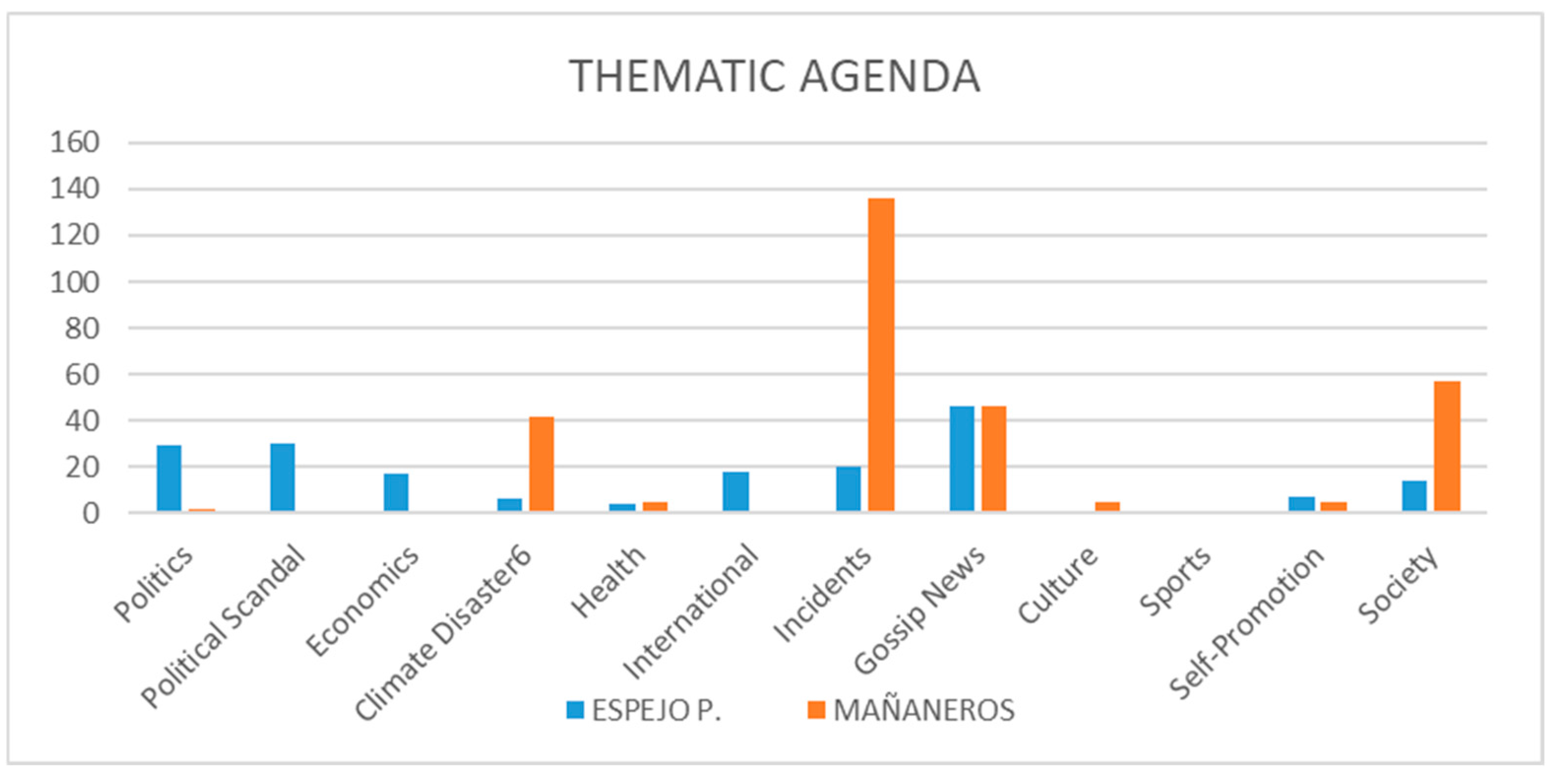
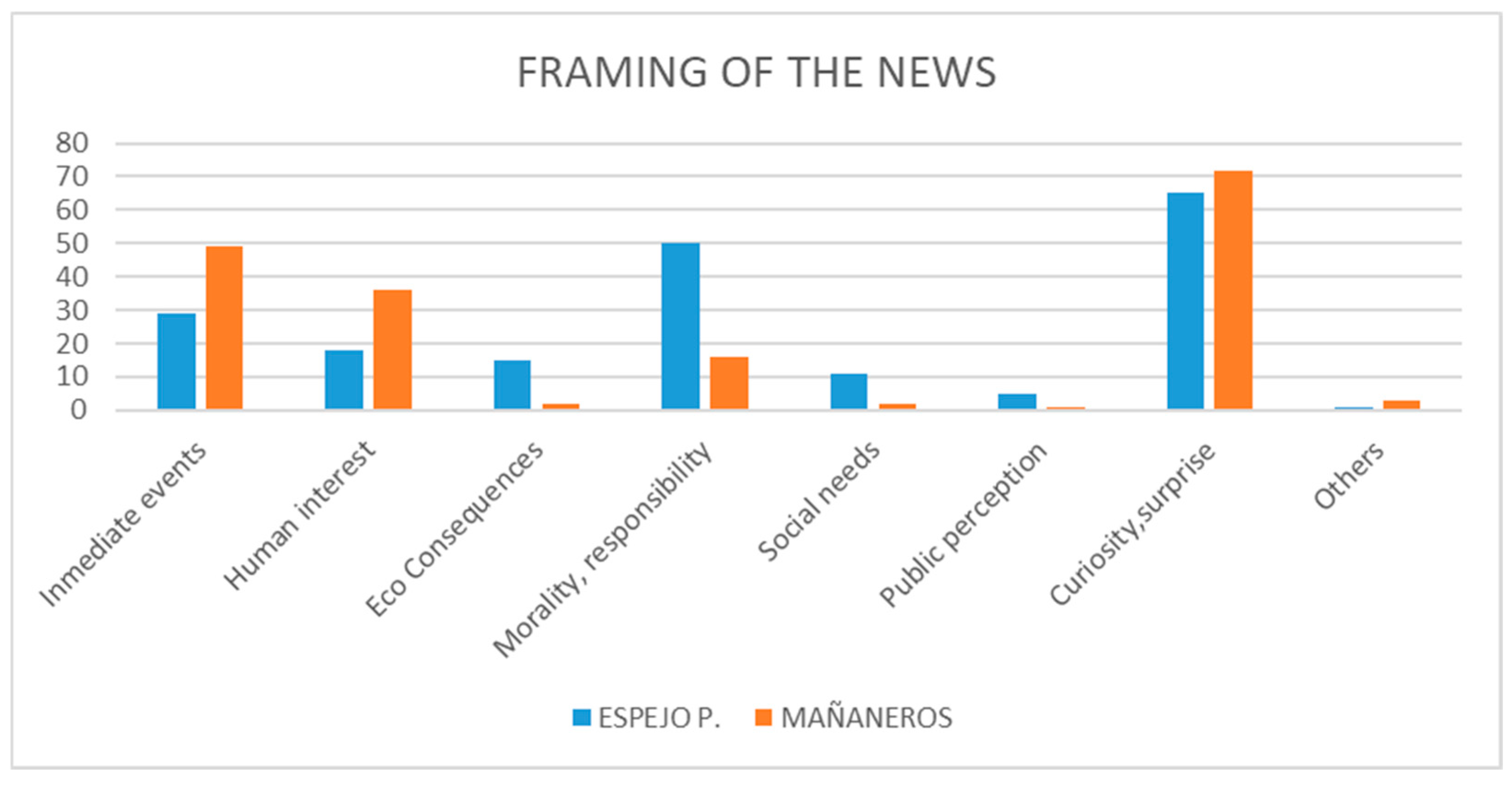

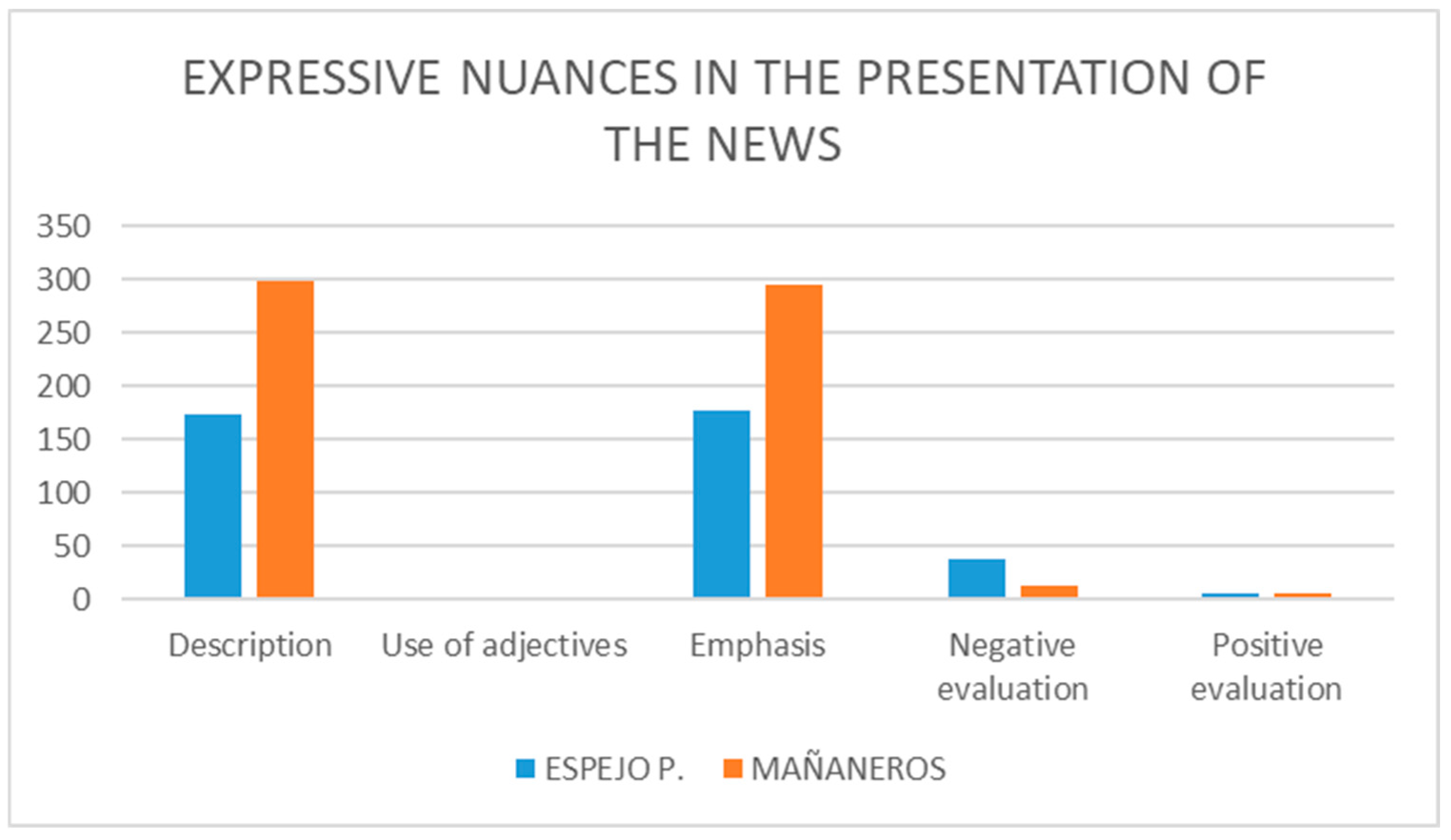
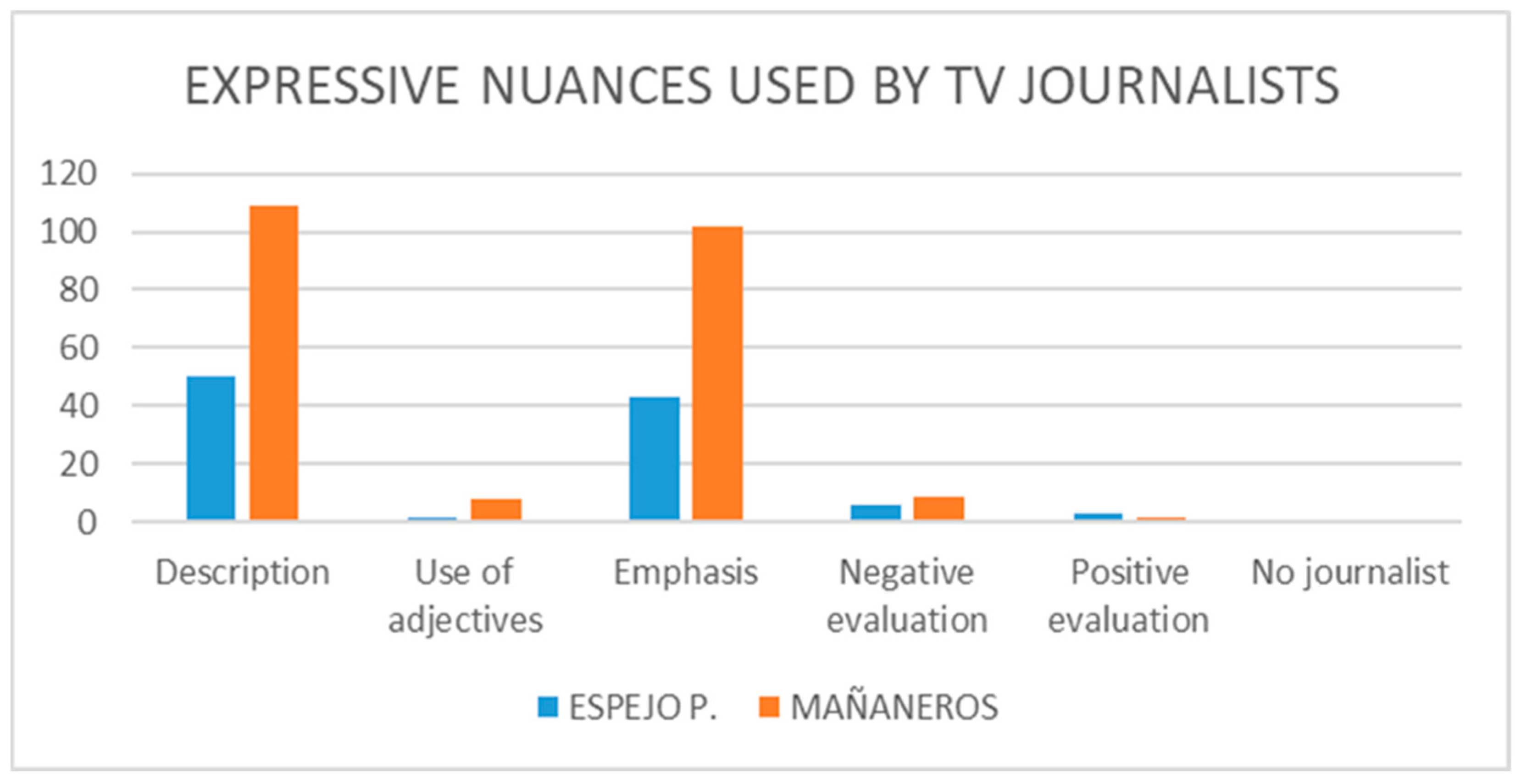
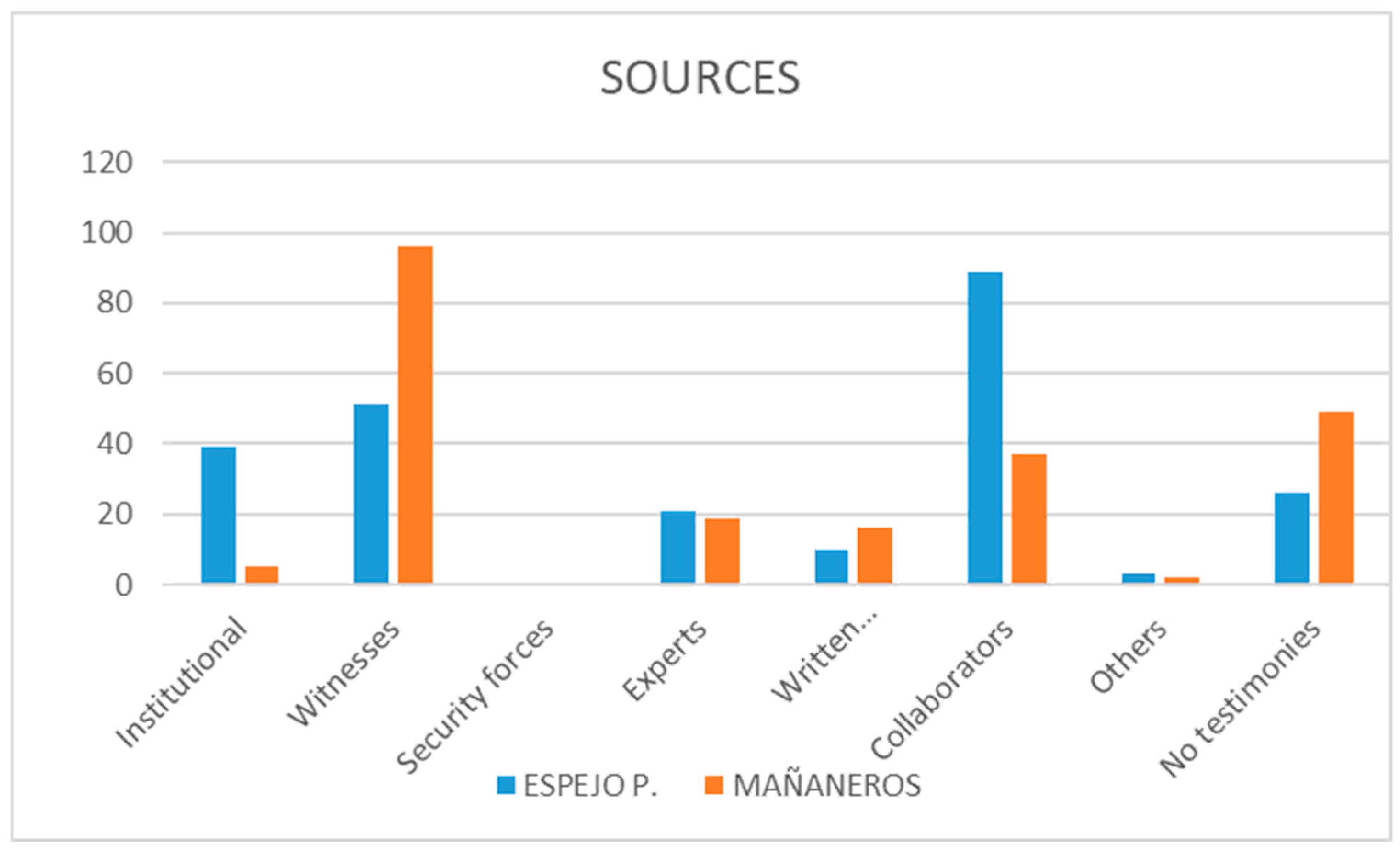
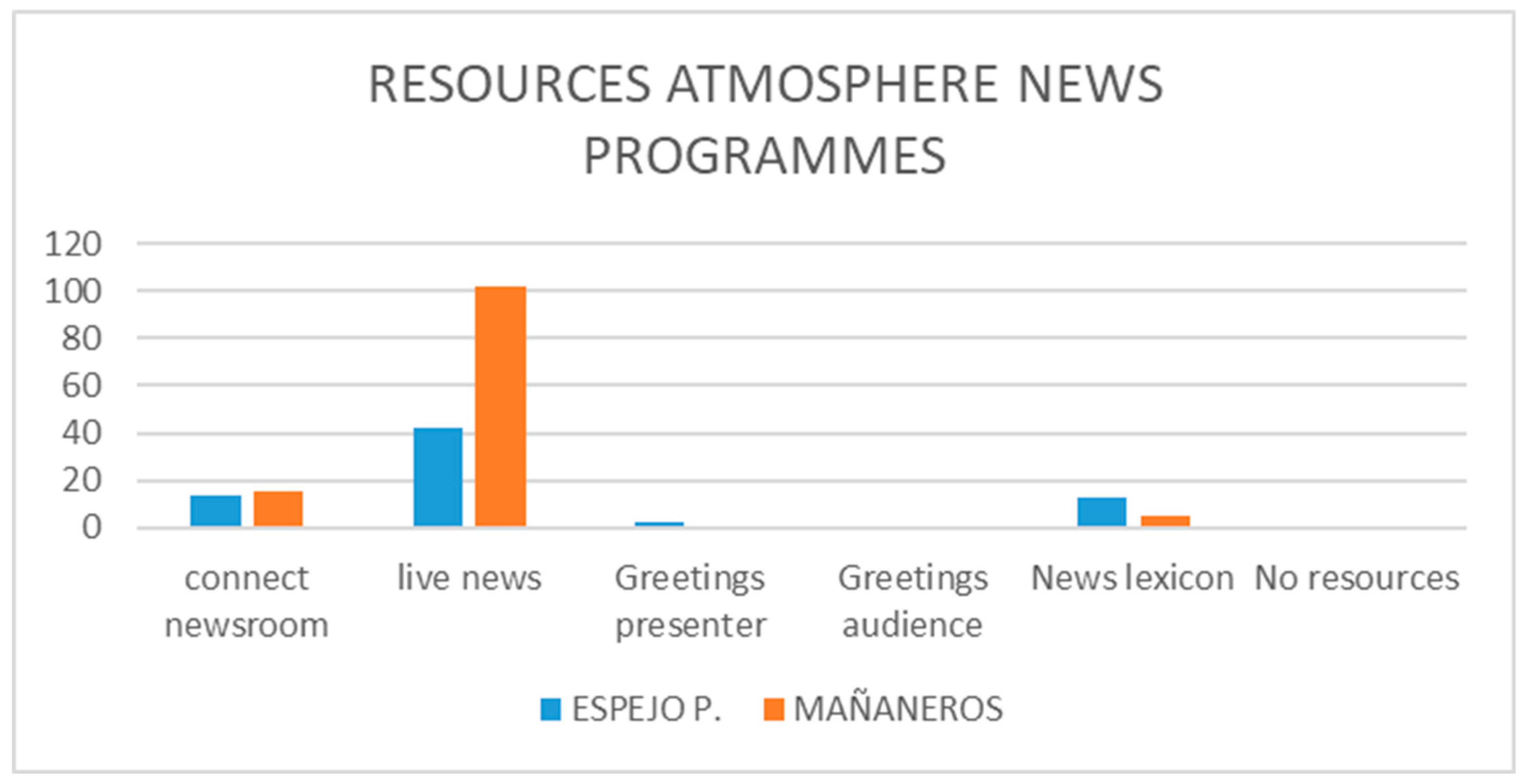

| Public Audiovisual Broadcasters | Private Television Groups | Print Media Conglomerates |
|---|---|---|
| RTVE (national) and 17 regional public networks serve diverse audiences | Mediaset España and Atresmedia control ~94% of TV market share | Prisa (El País, Cadena SER), Vocento (ABC, regional dailies), Planeta–Atresmedia (La Razón), and RCS-owned Unidad Editorial (El Mundo) dominate the newspaper market and increasingly span print, radio, and digital platforms |
| Program Name | Broadcast Dates Analysed | Duration per Episode | Year of Launch | Brief History/Context |
|---|---|---|---|---|
| Espejo Público | 6, 14, 17, 25 February, and 5 March 2025 (weekdays) | 270 min (08:55–13:30) | 1996 (weekly); 2006 (daily format) | Initially launched in 1996 as a weekly show, Espejo Público became a daily morning news magazine in 2006. Broadcast by Antena 3, it covers news, politics, and society, and is currently hosted by Susanna Griso. |
| Mañaneros | 6, 14, 17, 25 February, and 5 March 2025 (weekdays) | 240 min (10:40–15:00) | 2023 (as Mañaneros); rebranded 2025 | Morning magazine program broadcast by La 1 (RTVE). Originally launched as Mañaneros in 2023. It was rebranded Mañaneros 360 in April 2025 to shift focus toward social, economic, and political content. Hosted by Adela González and Javier Ruiz. |
| Analysis Unit Data: Issue Date/Content | |
|---|---|
| Variables | Categories |
| V1 number piece of news | |
| V2 thematic agenda | |
| 1- politics 2- politics/scandal 3- economy 4- natural disasters 5- health 6- international 7- incidents 8- gossip news 9- culture 10- sports 11- self-promotion | |
| V3 classification of the news | |
| 1- immediate current events 2- human interest 3- economic consequences 4- morality, responsibility 5- social needs 6- public perception 7- human curiosity, surprise 8- others | |
| V4 nature TV channel | |
| 1- public 2- private | |
| V5 format | |
| 1- summary 2- interview 3- edited news 4- news narrated from the set 5- report 6- talk-show/debate | |
| V6 expressive nuances in the presentation of the news | |
| 1- description of the event 2- use of qualifying adjectives 3- emphasis on phrases with intonation 4- negative evaluation of the fact 5- positive evaluation of the fact | |
| V7 expressive nuances used by the tv journalists | |
| 1- description of the event 2- use of qualifying adjectives 3- emphasis on phrases with intonation 4- negative evaluation of the fact 5- positive evaluation of the fact | |
| V8 use of spectacularisation elements | |
| 1- music 2- no music 3- use of ambient sound 4- close-up view | |
| V9 image composition | |
| 1- close-up view 2- medium shot 3- full shot 4- edited images 5- social and mobile media | |
| V10 sources | |
| 1- institutional representatives 2- witnesses 3- police and emergencies 4- experts 5- written testimonies with graphics and orally dramatised 6- opinions of collaborators on set 7- others 8- no testimonies | |
| V11 resources for the atmosphere of news programmes | |
| 1- connection with the programme’s newsroom 2- includes live news 3- journalists greeting the presenter 4- journalists greeting the audience 5- lexis of immediacy: breaking news, scoop, exclusive, etc… | |
| V12 type of live connections | |
| 1- live news (something happening at that specific moment) 2- detached live news (nothing is happening except our presence; maybe something happened before) 3- live and illustrative (when the action has already happened but the place is illustrative) 4- live and permanent (there is a relationship with the space but nothing is happening in that place) 5- live and contrary (one is at a place but talks about actions that occurred in other places) | |
Disclaimer/Publisher’s Note: The statements, opinions and data contained in all publications are solely those of the individual author(s) and contributor(s) and not of MDPI and/or the editor(s). MDPI and/or the editor(s) disclaim responsibility for any injury to people or property resulting from any ideas, methods, instructions or products referred to in the content. |
© 2025 by the author. Licensee MDPI, Basel, Switzerland. This article is an open access article distributed under the terms and conditions of the Creative Commons Attribution (CC BY) license (https://creativecommons.org/licenses/by/4.0/).
Share and Cite
Bañon-Castellón, L. Content Osmosis in Television Programmes: The Inclusion of News in the Spanish Magazines Espejo Público and Mañaneros. Journal. Media 2025, 6, 125. https://doi.org/10.3390/journalmedia6030125
Bañon-Castellón L. Content Osmosis in Television Programmes: The Inclusion of News in the Spanish Magazines Espejo Público and Mañaneros. Journalism and Media. 2025; 6(3):125. https://doi.org/10.3390/journalmedia6030125
Chicago/Turabian StyleBañon-Castellón, Lola. 2025. "Content Osmosis in Television Programmes: The Inclusion of News in the Spanish Magazines Espejo Público and Mañaneros" Journalism and Media 6, no. 3: 125. https://doi.org/10.3390/journalmedia6030125
APA StyleBañon-Castellón, L. (2025). Content Osmosis in Television Programmes: The Inclusion of News in the Spanish Magazines Espejo Público and Mañaneros. Journalism and Media, 6(3), 125. https://doi.org/10.3390/journalmedia6030125






